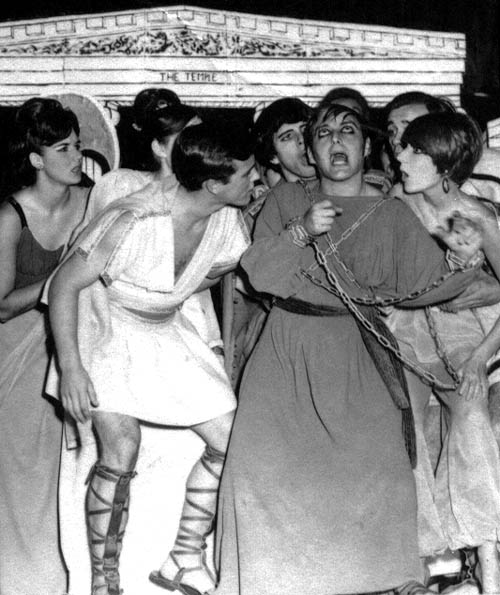Far From Home
Today, UH theatre director Sidney Berger is far from home. The University of Houston presents this series about the machines that make our civilization run, and the people whose ingenuity created them.
The room was very still in anticipation of the performance that was about to begin. The audience was small, approximately forty. But the response was astonishing. Cheers erupted and would not stop. Afterwards, we were given lunch and our plates were piled so high with food that it resembled a scene from a Charlie Chaplin comedy. It was that audience's only way of materially saying thank you for volunteering to entertain them.
A small theatre in, say, Ohio, or Nebraska? A hospital or home for the aged? Not quite. It was 1972 and some fifteen of us, performers from the University of Houston with myself as director and company manager, were on a U.S.O. tour of the Northeast Command, to entertain military personnel in Iceland, Greenland, Newfoundland and Labrador. The season was summer, which meant twenty-four hours of daylight; something our sleep cycles had real difficulties in adjusting to.
One icy morning, a major asked if we'd be willing to sacrifice our one day off and fly up to a weather station near the North Pole to entertain isolated military personnel. We were quick to agree. Several small helicopters lifted off with three of us in each. As we landed on a desolate, frozen beach, the first thing we noticed was a complete absence of wind and an eerie silence. On the way to the station, we passed a series of small shacks. What were these, I asked? Well, replied our host, when the fierce Arctic wind erupts, you take shelter within minutes or freeze to death.
This was not the first U.S.O. tour I'd led. I was a veteran of six to various commands all over the world. I'd also taken productions of the classic musicals, Brigadoon and The Boyfriend to the Pacific, Rodgers' and Hart's, The Boys from Syracuse to the Northeast Command, and Sweet Charity to Germany.
In the Pacific Command we played Taiwan, Japan, Korea, Guam, the Philippines and Okinawa. Performing on the DMZ, that very dangerous corridor separating North from South Korea, we were watched by tough Marines and, on a nearby hill, by North Korean guards with binoculars.
In the Philippines, we were bussed through virtually impenetrable jungle to a naval base at Subic Bay. And we were warned that it was a dangerous journey since communist guerillas held much of that terrain. We made it, tense but unscathed. These tours were different from those of the past. Instead of rock stars and film celebrities, these were young, talented students who brought a taste of home to the troops as well as entertainment.
On the flight up to the Arctic, we'd been a laughing, playful lot -- full of ourselves and the fun of it all. But now, on the transport plane back to the states, the mood is quiet -- thoughtful. If we'd affected those soldiers' lives, this had been a two way street. For they had touched us every bit as deeply.
I'm Sidney Berger, at the University of Houston, where we're interested in the way inventive minds work.
When one thinks of U.S.O shows, the mind inevitably goes to Bob Hope and World War II. But few remember that in and outside every war this country has fought, to the present day, the U.S.O. was there to entertain the troops. We sometimes forget that these are lonely men and women, who left families to ship overseas and fight our battles. However, in my experience, having directed and escorted six U.S.O. tours to virtually every command where our troops were stationed, young American students made the greatest impact on soldiers, sailors, airmen and marines who were far from home, clearly making a greater impact than the standard fare of rock shows (that we frequently followed) and star turns. Home is what these young people brought them and home was what they all yearned for. Sadly, the once-flourishing U.S.O. college and university program is gone. But we still have American military all over the world and echoes of home is what they hunger for the most. I know. I've been there.
(By the way, actor Randy Quaid was scheduled for the Northeastern Command tour described in this episode; but had to be replaced at the last moment. He'd just been hired for his first film role -- as Lester Marlow in the Academy Award winning movie, The Last Picture Show. These students were a remarkably talented group.)
Sidney Berger is the Director of Theatre at the University of Houston, founder and Producing Director of the Houston Shakespeare Festival, co-founder and producer of the Children's Theatre Festival, Dr. Berger also co-founded the Shakespeare Theatre Association of America and served as its first president. He has directed over ninety productions on the UH campus, as well as over twenty-seven productions for the Shakespeare Festival. He has also been represented by plays he has directed throughout the city, notably at the Alley Theatre, where he served as associate artist, with many productions. As Artistic Consultant at Stages Repertory Theatre, he has directed many plays including Edward Albee's All Over with Mr. Albee in attendance. At Theatre Under the Stars, he directed the fortieth anniversary production of My Fair Lady with Noel Harrison. He serves on the board of London's Shakespeare's Globe and has received the university's highest honor, the Esther Farfel Award. In 1997 Dr. Berger was elected to the College of Fellows of the American Theatre.
Below: Three images from the Northeast Command tour of the play, The Boys from Syracuse, described above.


